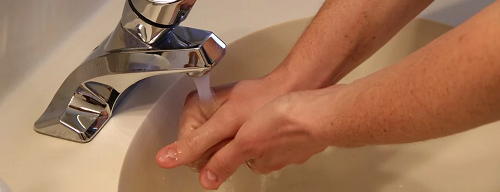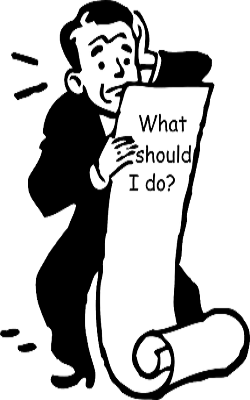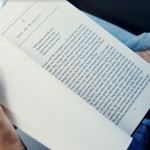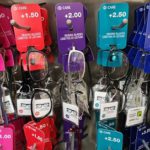So you love to read but can’t quite make out the text without squinting or giving yourself a massive headache. You know that you could get yourself a pair of reading glasses but that doesn’t really appeal to you. So what about contact lenses? Is there such a thing as contact lenses for reading only?
The answer is the same answer I give for ~99% of vision-related questions I get asked: It depends!
Don’t worry, I’ll get more specific.
The reason why there is not a straightforward answer is that there are a lot of different scenarios to consider. Let’s run through them all and hopefully you will find that one you can relate to.
Perfect Distance Vision & Blurry Near Vision
This is the simplest scenario. Your vision is perfect in the distance and you’ve never needed glasses to help you see far away. However, you can’t hold reading material as close as you’d like without it becoming too difficult to see.
This is the situation that most people who have never needed glasses in their life find themselves in their early 40’s. The process that causes this is known as Presbyopia and it’s a perfectly normal occurrence.
Would contact lenses for reading only help here?
For certain activities, yes, but generally speaking, no.
Wow, I just can’t give any straight answers, can I?
Reading Glasses Are Quick
Here’s the thing. Contact lenses are not as easy to put on and take off as reading glasses. With a pair of reading glasses, you can put them on in under 2 seconds and you can take them off in even less time. Moreover, you can put on reading glasses virtually anywhere you happen to be. This is not at all the case with contact lenses.

Contact Lenses Require Time & Clean Hands
Inserting contact lenses will require a small, but a considerable amount of your time. You’ll need to walk over to a sink to wash your hands (a crucial step!), remove the contacts from their packaging and insert them in your eyes, then return to where you plan on doing your reading (which hopefully is not too far as you’re about to find out).

There Goes Your Distance Vision
The time it takes to insert and remove contact lenses aside, that’s not the biggest problem with contact lenses for reading only. The real issue is the distance vision. Once your ‘reading contact lenses’ are on, you will see incredibly well up close, but your distance vision will be very blurry. So much so that it may make it difficult or even impossible (let alone dangerous) to navigate from one place to another.

Perhaps In Certain Situations…
If you are doing anything that requires you to alternate between seeing well up close and far away, it would be best to consider other options.
You may enjoy contact lenses for reading only if, for whatever reason, you are required to look close up (and only close up) for prolonged periods of time. If you are happier performing this activity with contact lenses then reading glasses, then, by all means, go for it. Just keep in mind that you would have to put the contact lenses in and take them out immediately before and after said activity.

Verdict
I’m not saying that it can’t work for certain people in the right circumstance, but I have never come across anyone in a situation where this has been the best solution… not yet anyway.
Blurry Distance Vision & Blurry Near Vision (Both Eyes)
There are several different combinations of visual disorders that could put you in this category. You are either:
Under 40 and:
- Highly nearsighted
- Highly farsighted
- Highly astigmatic
OR
Over 40 and:
- Mildly or highly nearsighted (but not moderately nearsighted)
- Moderately to highly farsighted
- Highly astigmatic
Whichever the case, the outcome with regards to wearing contact lenses for reading only is the same.
Would contact lenses for reading only help here?
No.
Keep in mind that in all of the situations above (with the possible except of Under 40 and: #1 & #3), the strength of contact lenses that would help you see clearly while reading would not make the vision worse in the distance.
That being the case there is just no way it would be anywhere close to convenient enough to wear contact lenses while reading and then switching to different contact lenses for distance viewing over and over all day long.
In this situation, instead of trying to find contact lenses for reading only, it would be a lot more appropriate to consider multifocal contact lenses. These are contact lenses that allow you to see properly (~85-90% clear) in both the distance as well as up close.
When The Eyes Are Not The Same
Ok, here we go…
Under 40 and:
- No prescription in one eye & moderate nearsightedness in the other.
- Can use a ‘reading’ contact lens in the eye with ‘no prescription’ to balance out the vision while reading.
- No prescription in one eye & high nearsightedness in the other.
- Can use a ‘reading’ contact lens in the highly nearsighted eye to balance out the vision while reading.
- No prescription in one eye & farsightedness in the other.
- Can use a ‘reading’ contact lens in the farsighted eye to balance out the vision while reading.
- No prescription in one eye & astigmatism in the other.
- Can use a contact lens for astigmatism in one eye to sharpen up vision while reading.
- One eye is moderately nearsighted and the other is farsighted.
- Can use a ‘reading’ contact lens in the farsighted eye to balance out the vision while reading.
Above 40 and:
- No prescription in one eye & moderate nearsightedness in the other.
- Can use a ‘reading’ contact lens in the eye with ‘no prescription’ to balance out the vision while reading.
- All other situations.
- Will need different contact lenses in each eye depending on the situation.
Keep in mind!
In many of the above situations, the contact lens that you use for reading will make that eye see blurry in the distance. Since the other eye can see well in the distance you could leave the reading contact lens in your eye all day long. This will result in a form of vision correction known as monovision.
Monovision is when one eye is made to see well in the distance and the other eye is made to see well up close. It is most commonly used in people above the age of 40 to prevent the need for reading glasses or multifocal contact lenses. The downsides of monovision are quite obvious; you cannot see clearly in the distance and up-close at the same time.

Summary
Wearing contact lenses for reading only is not a common practice due to the inconvenience of inserting and removing the contact lenses. Depending on your individual situation, it is a lot more common to use multifocal contact lenses or use regular contact lenses to achieve monovision.
I don’t blame you if you read through this article and were left a little confused. If you are having difficulty reading and you want to use contact lenses but you’re not sure what options are available to you, I would be happy to throw out some suggestions that you can bring up with your eye doctor. Just share the details of your situation in the comments below.




Leave a Reply